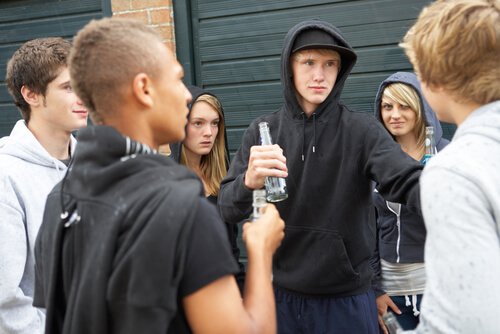Adolescence - 7 Tips for Parents with Rebellious Teenagers

Adolescence is an important phase in an individual’s growth, and one in which the foundations of our identity are laid. Many families don’t usually accept – or do so reluctantly – the process of an adolescent becoming independent. They still consider their children to be just children.
But teenagers tend to believe themselves to be capable, or to have initiative, and they set this “family disconnection” in motion. This is an unavoidable stop on the road to self-dependence or autonomy (Lamas 2007). Sometimes this road is a rocky one though, and the desire for independence can turn into rebellion.
It is in this context that most of the conflicts between adolescents and their families begin. During these years, adolescents often blame their discomfort on members of their families. They become frustrated and have difficulties relating intelligently to other people.
This is why it is essential that the family helps the teenager to find their place in life. They should help the adolescent to find effective strategies that allow him or her to improve their relationship with the outside world. Sometimes adults forget that in adolescence teens still retain many of their childish characteristics as they try to interact in increasingly complex contexts. However, we cannot treat them as children, and that is precisely where the difficulty lies.
Accompany your child
The interest in exploring strategies independently is what leads the adolescent to behave strangely. They are trying to find their place in a world that, little by little, is starting to open up for them. Don’t forget that at this age they are still somewhat lacking in knowing how to interact in external environments. They will often feel lost, but they won’t call out for help either because that would compromise the very independence they are trying so hard to achieve.
Children may adopt family strategies and become “pre-fabricated” adolescents, or they may break away abruptly from what they have been taught, and search for their own identity. Accompanying them in this process is vital for them to be able to take these steps from childhood to adulthood. If the family isn’t willing to take part in this process, then it won’t be long before rebellious tendencies are seen in the teenager.
“There are no problem teenagers; they are simply children who grew up suffering”

The family structure and adolescence
To demonstrate the influence of the family structure on the origin and continuation of the problems in adolescence, we often use Fishman’s description of rebellious adolescents (Lamas 2007). The rebellious adolescent grows up in a family structure characterized by porous boundaries and limits. This is evident in families where the members of the family are intimately interconnected.
In this type of family, everyone knows everyone. Porous personal limits often mean that these families follow advice that comes from the outside. The low hierarchy that characterizes these family structures makes the problem worse, and the children become powerful members within the family.
Sometimes, the teens respond to frustrations with an excessive rage and establish relationships with their peers and partners which are full of passion, intense crushes, jealousy and breakups followed by spectacular reconciliations. This intolerance of frustration can provoke rebellious and confrontational teenagers.
In several learning theories, especially behavioral learning, we find that the best way to raise healthy and functional adolescents is a childhood in which there are achievements, but also challenges and frustrations. If we never let our children be frustrated by not achieving certain goals, we will be educating selfish monsters. They will believe they have the right to have everything, just for mere fact that they are who they are. This can, on occasions, create rebellious teenagers.

More is not better
This style of parenting increasingly occurs in the family nuclei. We think that if we let our children have everything then that means we are better parents, but nothing could be further from the truth. If we raise children in a culture where we do everything for them, then when they reach adolescence they won’t understand the new demands we put on them, and hence may become problematic adolescents and tyrants.
“Young people have always had the same problem; how to be rebellious and conform at the same time “
-Quentin Crisp-
Bonding with your children
The objective of this part of the article, together with the 7 tips we are about to give you, is not to offer you some sort of “expert advice”. It is rather to encourage parents to connect and find a way to bond with their children and teenagers. Not all the tips will apply to the same family or the same adolescent, nor do they apply to the same teen and family all the time. That is why you should consider the best ways you can apply this advice to your individual situation.

First, if we have a positive relationship with our adolescent son or daughter, then it will be easier to be a positive influence on them. This influence can also be negative if we don’t carry it out correctly. Remember too that, if you don’t have this type of relationship, it is never too late to try and create it. To do so, it is essential that we know the traits and interests of our child. This is how we’ll be able to connect with them. To put it simply, we are going to have to walk in their world, and so we need to understand how that world works.
7 tips to help you
Let’s have a look at these 7 general ideas that can help us deal with rebellious teens:
- Establish limits. Living together in a family requires rules that must be respected. It is also important that our child knows what the consequences of disobeying those rules are.
- Investing time and energy to improve how we raise our children. If we do this, the chances of solving any problematic situations increase considerably.
- Be firm in taking decisions, and make sure you practice what you preach. We must set an example and give them the opportunity to follow it.
- Avoid comparisons. Constantly comparing them to their siblings or friends can damage their self-concept and make them defiant because of it.
- Avoid unnecessary pressures. Teens have to have their own goals. Adults must accompany them in their choices, but we must not put pressure on them to fulfill goals that we couldn’t when we were young.
- Accept that our children are not perfect. If our child gets things wrong then they should accept the consequences, even though that will hurt us and we’ll feel the duty to protect them.
- Be honest with them. Sincerity is a tool that we do not usually use much with children. Family relationships are so hierarchical that sometimes we ignore some of the most effective techniques of approaching teenagers.
Just be with your teen
To sum up, adolescents are, almost simultaneously, distrustful and naive, hopeful and apathetic, communicative and closed, cautious and risk takers. Many teenagers are a pure contradiction with rich nuances – that is why they confuse us so much.

Most of them are worried about their social image. They either show this directly, or try to make out that they don’t care what others think. They appreciate our help, but what they appreciate most is our trust and the opportunity to make mistakes. Taking all of this into account, understanding them or worrying about them is not as important as simply being there for them.
During adolescence children seem to be so difficult to teach, but, if you do it well, your teachings will last a lifetime.
Bibliographic references
Barkley, R. A., & Benton, C. M. (2000). Your Defiant Teen: 10 Tips to Resolve Conflict and Build a Better Relationship with your Child (Vol. 48). Planet Group (GBS).
Céspedes, A. (2007). Children with Tantrums, defiant teenagers. How to best manage behavior disorders in children (5th ed.). Santiago de Chile: Unlimited SA.
González Barrón, R., Montoya Castilla, I., Casullo, M. M., & Bernabéu Verdú, J. (2002). Relationship Between Styles and Strategies for Psychological Well-being in Adolescents. Psicothema, 14 (2).
Lamas, C. (2007). Understanding Problematic Adolescence. Revista Redes, 18, 63-85.
Quiroga, S., Paradiso, L., Cryan, G., Auguste, L., & Zaga, D. (2004). A Therapeutic Approach for Pre-Teens with Problematic Behavior: Challenging Negativist Disorder and Dissocial Disorder. In the 11th Research Conference. School of Psychology, University of Buenos Aires.
Quiroga, S. E., & Cryan, G. (2007). Manifestations of Violence in High-risk Adolescents. The 14th Research Conference and Third Meeting of Researchers in Psychology of Mercosur, School of Psychology, University of Buenos Aires.
Rizo Ruiz, A. B. (2014). Cognitive-behavioral Intervention in a Case of Defiant Negativist Disorder in a Teenager. Journal of Clinical Psychology with Children and Adolescents.
Selekman, M. (1996). Open Roads for Change: Brief Therapy Solutions for Adolescents with Problems. Editorial GEDISA.
Adolescence is an important phase in an individual’s growth, and one in which the foundations of our identity are laid. Many families don’t usually accept – or do so reluctantly – the process of an adolescent becoming independent. They still consider their children to be just children.
But teenagers tend to believe themselves to be capable, or to have initiative, and they set this “family disconnection” in motion. This is an unavoidable stop on the road to self-dependence or autonomy (Lamas 2007). Sometimes this road is a rocky one though, and the desire for independence can turn into rebellion.
It is in this context that most of the conflicts between adolescents and their families begin. During these years, adolescents often blame their discomfort on members of their families. They become frustrated and have difficulties relating intelligently to other people.
This is why it is essential that the family helps the teenager to find their place in life. They should help the adolescent to find effective strategies that allow him or her to improve their relationship with the outside world. Sometimes adults forget that in adolescence teens still retain many of their childish characteristics as they try to interact in increasingly complex contexts. However, we cannot treat them as children, and that is precisely where the difficulty lies.
Accompany your child
The interest in exploring strategies independently is what leads the adolescent to behave strangely. They are trying to find their place in a world that, little by little, is starting to open up for them. Don’t forget that at this age they are still somewhat lacking in knowing how to interact in external environments. They will often feel lost, but they won’t call out for help either because that would compromise the very independence they are trying so hard to achieve.
Children may adopt family strategies and become “pre-fabricated” adolescents, or they may break away abruptly from what they have been taught, and search for their own identity. Accompanying them in this process is vital for them to be able to take these steps from childhood to adulthood. If the family isn’t willing to take part in this process, then it won’t be long before rebellious tendencies are seen in the teenager.
“There are no problem teenagers; they are simply children who grew up suffering”

The family structure and adolescence
To demonstrate the influence of the family structure on the origin and continuation of the problems in adolescence, we often use Fishman’s description of rebellious adolescents (Lamas 2007). The rebellious adolescent grows up in a family structure characterized by porous boundaries and limits. This is evident in families where the members of the family are intimately interconnected.
In this type of family, everyone knows everyone. Porous personal limits often mean that these families follow advice that comes from the outside. The low hierarchy that characterizes these family structures makes the problem worse, and the children become powerful members within the family.
Sometimes, the teens respond to frustrations with an excessive rage and establish relationships with their peers and partners which are full of passion, intense crushes, jealousy and breakups followed by spectacular reconciliations. This intolerance of frustration can provoke rebellious and confrontational teenagers.
In several learning theories, especially behavioral learning, we find that the best way to raise healthy and functional adolescents is a childhood in which there are achievements, but also challenges and frustrations. If we never let our children be frustrated by not achieving certain goals, we will be educating selfish monsters. They will believe they have the right to have everything, just for mere fact that they are who they are. This can, on occasions, create rebellious teenagers.

More is not better
This style of parenting increasingly occurs in the family nuclei. We think that if we let our children have everything then that means we are better parents, but nothing could be further from the truth. If we raise children in a culture where we do everything for them, then when they reach adolescence they won’t understand the new demands we put on them, and hence may become problematic adolescents and tyrants.
“Young people have always had the same problem; how to be rebellious and conform at the same time “
-Quentin Crisp-
Bonding with your children
The objective of this part of the article, together with the 7 tips we are about to give you, is not to offer you some sort of “expert advice”. It is rather to encourage parents to connect and find a way to bond with their children and teenagers. Not all the tips will apply to the same family or the same adolescent, nor do they apply to the same teen and family all the time. That is why you should consider the best ways you can apply this advice to your individual situation.

First, if we have a positive relationship with our adolescent son or daughter, then it will be easier to be a positive influence on them. This influence can also be negative if we don’t carry it out correctly. Remember too that, if you don’t have this type of relationship, it is never too late to try and create it. To do so, it is essential that we know the traits and interests of our child. This is how we’ll be able to connect with them. To put it simply, we are going to have to walk in their world, and so we need to understand how that world works.
7 tips to help you
Let’s have a look at these 7 general ideas that can help us deal with rebellious teens:
- Establish limits. Living together in a family requires rules that must be respected. It is also important that our child knows what the consequences of disobeying those rules are.
- Investing time and energy to improve how we raise our children. If we do this, the chances of solving any problematic situations increase considerably.
- Be firm in taking decisions, and make sure you practice what you preach. We must set an example and give them the opportunity to follow it.
- Avoid comparisons. Constantly comparing them to their siblings or friends can damage their self-concept and make them defiant because of it.
- Avoid unnecessary pressures. Teens have to have their own goals. Adults must accompany them in their choices, but we must not put pressure on them to fulfill goals that we couldn’t when we were young.
- Accept that our children are not perfect. If our child gets things wrong then they should accept the consequences, even though that will hurt us and we’ll feel the duty to protect them.
- Be honest with them. Sincerity is a tool that we do not usually use much with children. Family relationships are so hierarchical that sometimes we ignore some of the most effective techniques of approaching teenagers.
Just be with your teen
To sum up, adolescents are, almost simultaneously, distrustful and naive, hopeful and apathetic, communicative and closed, cautious and risk takers. Many teenagers are a pure contradiction with rich nuances – that is why they confuse us so much.

Most of them are worried about their social image. They either show this directly, or try to make out that they don’t care what others think. They appreciate our help, but what they appreciate most is our trust and the opportunity to make mistakes. Taking all of this into account, understanding them or worrying about them is not as important as simply being there for them.
During adolescence children seem to be so difficult to teach, but, if you do it well, your teachings will last a lifetime.
Bibliographic references
Barkley, R. A., & Benton, C. M. (2000). Your Defiant Teen: 10 Tips to Resolve Conflict and Build a Better Relationship with your Child (Vol. 48). Planet Group (GBS).
Céspedes, A. (2007). Children with Tantrums, defiant teenagers. How to best manage behavior disorders in children (5th ed.). Santiago de Chile: Unlimited SA.
González Barrón, R., Montoya Castilla, I., Casullo, M. M., & Bernabéu Verdú, J. (2002). Relationship Between Styles and Strategies for Psychological Well-being in Adolescents. Psicothema, 14 (2).
Lamas, C. (2007). Understanding Problematic Adolescence. Revista Redes, 18, 63-85.
Quiroga, S., Paradiso, L., Cryan, G., Auguste, L., & Zaga, D. (2004). A Therapeutic Approach for Pre-Teens with Problematic Behavior: Challenging Negativist Disorder and Dissocial Disorder. In the 11th Research Conference. School of Psychology, University of Buenos Aires.
Quiroga, S. E., & Cryan, G. (2007). Manifestations of Violence in High-risk Adolescents. The 14th Research Conference and Third Meeting of Researchers in Psychology of Mercosur, School of Psychology, University of Buenos Aires.
Rizo Ruiz, A. B. (2014). Cognitive-behavioral Intervention in a Case of Defiant Negativist Disorder in a Teenager. Journal of Clinical Psychology with Children and Adolescents.
Selekman, M. (1996). Open Roads for Change: Brief Therapy Solutions for Adolescents with Problems. Editorial GEDISA.
All cited sources were thoroughly reviewed by our team to ensure their quality, reliability, currency, and validity. The bibliography of this article was considered reliable and of academic or scientific accuracy.
Barkley, R. A., & Benton, C. M. (2000). Hijos desafiantes y rebeldes: consejos para recuperar el afecto y lograr una mejor relación con su hijo (Vol. 48). Grupo Planeta (GBS).
Céspedes, A. (2007). Niños con pataleta, adolescentes desafiantes. Cómo manejar los trastornos de conductas en los hijos (5a ed.). Santiago de Chile: Unlimited SA.
González Barrón, R., Montoya Castilla, I., Casullo, M. M., & Bernabéu Verdú, J. (2002). Relación entre estilos y estrategias de afrontamiento y bienestar psicológico en adolescentes. Psicothema, 14(2).
Lamas, C. (2007). Para comprender la adolescencia problemática. Revista Redes, 18, 63-85.
Quiroga, S., Paradiso, L., Cryan, G., Auguste, L., & Zaga, D. (2004). Abordaje terapéutico para adolescentes tempranos con conductas perturbadoras: Trastorno Negativista Desafiante y Trastorno Disocial. In XI Jornadas de Investigación. Facultad de Psicología-Universidad de Buenos Aires.
Quiroga, S. E., & Cryan, G. (2007). Manifestaciones de la violencia en adolescentes de alto riesgo. In XIV Jornadas de Investigación y Tercer Encuentro de Investigadores en Psicología del Mercosur. Facultad de Psicología-Universidad de Buenos Aires.
Rizo Ruiz, A. B. (2014). Intervención cognitivo-conductual en un caso de trastorno negativista desafiante en una adolescente. Revista de Psicología Clínica con Niños y Adolescentes, 1(1).
Selekman, M. (1996). Abrir caminos para el cambio: soluciones de terapia breve para adolescentes con problemas. Editorial GEDISA.
This text is provided for informational purposes only and does not replace consultation with a professional. If in doubt, consult your specialist.







